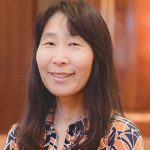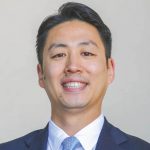The World Tribune held a roundtable discussion with SGI-USA national leaders to discuss the importance of studying the Gosho, the writings of Nichiren Daishonin. SGI-USA General Director Adin Strauss, Women’s Leader Naoko Leslie, Men’s Leader Kevin Moncrief, Young Women’s Leader Maya Gunaseharan and Young Men’s Leader Ryo Kuroki share their thoughts and experiences.
World Tribune: Thank you for speaking to us about your thoughts on studying the Gosho. Why is it important to prioritize reading Nichiren Daishonin’s writings?

Kevin: Ikeda Sensei says that reading the Gosho is fundamental to establishing and maintaining a complete Buddhist practice. This year, when SGI Vice President Yoshiki Tanigawa visited the U.S., he cited the following guidance from second Soka Gakkai President Josei Toda: “You should read each line of the Gosho with a deep personal conviction in its truth” (see June 10, 2022, World Tribune to read the full address). The truth of the Gosho is undisputable.

Naoko: Yes, Nichiren Daishonin’s words are contagious! Reading the Gosho helps us refute the doubts in our hearts and win over our fundamental ignorance. We can open our eyes to the greatness of our lives.
When I was a young woman, I decided to read the entire Gosho. I originally thought that because Nichiren Daishonin wrote these letters in the 13th century, it was no more than a historical artifact, but I was astonished to realize that everything that was written was related to my own life! The Gosho is a living thing.
WT: Members have expressed that it can be intimidating to read the Gosho. Do you have any tips on how to best study it?

Maya: I feel intimidated when I forget the purpose of Buddhist study—which is to help us learn how to practice Buddhism correctly and live the greatest life each day. If we think that the purpose is to become a Buddhist scholar or expert, it can be intimidating! I often study the Gosho together with my publications or Ikeda Sensei’s guidance. When a Gosho passage is referenced, I go to my copy of The Writings of Nichiren Daishonin, read the background for more context and then read the Gosho. I find that reading the Gosho together with Sensei’s guidance helps me consider how to put it into action in my own life, just as he has done.

Ryo: That’s true. And even reading a single line or phrase of the Gosho can develop one’s faith tremendously. I’ve learned that it’s OK to not completely understand it when you first read it. Rather, what’s important is to find a specific passage that resonates with you and do your best to apply it to your daily life. When we do this, we can actually “read” the Gosho with our life and gain a deeper understanding of its meaning. This strengthens our conviction and ultimately, enables us to encourage others.
WT: Can you share a personal experience about how a Gosho passage helped you during a difficult time?

Adin: My father underwent triple bypass surgery in 1999 when he was 83 years old. We were told that if he could make it through the first few days in post-op, there would be no problem. Well, the operation went well. But he developed severe pneumonia. It was unbelievably painful watching him try to breathe.
At this time, I felt very weakhearted—I did not feel as though I could beat this back with my Buddhist practice. My family was quite certain that he was not going to make it out.
At that critical juncture, I received guidance from a senior leader, who encouraged me not to give up and to base everything on firm prayer. I read Sensei’s guidance and the Gosho eagerly—especially this passage from “Reply to Yasaburo”:
You must be firmly resolved. Do not begrudge your fief; do not think of your wife and children. And do not depend on others. You must simply make up your mind. Look at the world this year as a mirror. The reason that you have survived until now when so many have died was so that you would meet with this affair. This is where you will cross the Uji River. This is where you will ford the Seta. This will determine whether you win honor or disgrace your name. … You should pray intently that Shakyamuni, Many Treasures and the Buddhas of the ten directions will all gather and take possession of your body to assist you. (The Writings of Nichiren Daishonin, vol. 1, p. 829)
I determined to chant passionately with these words in my heart to be able to show proof of the Gohonzon’s power. Engraving this Gosho in my life, I began to feel a strange confidence that my father was going to make it through.
Soon his lungs began to clear. His vital signs stabilized, and they moved him out of the intensive care unit. He spent a total of eight weeks in the ICU, but when he got out, he was filled with even more determination to go home.
This experience taught me the power of basing my life on the Gosho in crucial moments. We can “dye” our lives into the “color of Buddhahood” by repeatedly reading, studying and striving to internalize and apply the Gosho.
Maya: What a powerful experience. For me, I learned the power of the Gosho when I was in college. I had just transferred to a new school and, simply put, was deeply suffering in every area of my life! One day when complaining about all my struggles, a friend in faith asked me if I had ever read “The Eight Winds.” I decided to pick it up and struggled to digest most of it the first few times through. But the essence was captured in this line: “Worthy persons deserve to be called so because they are not carried away by the eight winds: prosperity, decline, disgrace, honor, praise, censure, suffering, and pleasure” (WND-1, 794).
As I chanted to understand this passage, I came to the conclusion that I wanted to be a worthy person who was not carried away by the eight winds. I wanted to become immovable. So, I began to pray that way, and before I knew it, I could see so clearly how consistently swayed I was by my environment. As I determined to become stronger and made causes in the realm of faith, my life indeed strengthened, and I completely transformed my suffering into great joy. Now, I have such appreciation for those struggles, as they helped me understand what it means to be a “worthy person.”
WT: Do you have a favorite Gosho passage?
Naoko: I have so many! But this is the passage I live by every day: “Single-mindedly chant Nam-myoho-renge-kyo and urge others to do the same; that will remain as the only memory of your present life in this human world” (“Embracing the Lotus Sutra,” WND-1, 64).
This is straight to the point. If chanting and planting seeds of Buddhahood represent the only memory of this lifetime, I want to tell other people about Nam-myoho-renge-kyo! This keeps me going so that I can devote myself to the happiness of others by joyfully planting seeds every day!
Ryo: My favorite passage is from “The Heritage of the Ultimate Law of Life.” Nichiren states:
It must be ties of karma from the distant past that have destined you to become my disciple at a time like this. Shakyamuni and Many Treasures certainly realized this truth. The sutra’s statement, “Those persons who had heard the Law dwelled here and there in various Buddha lands, constantly reborn in company with their teachers,” cannot be false in any way. (WND-1, 217)
Right after graduating from college, I was lost, searching for purpose in life. I felt a deep spiritual void. After starting to participate more in SGI activities, I began questioning the meaning and significance of my relationship with Sensei. When I read this passage, something shifted in my heart. I felt as though Nichiren Daishonin was assuring me that I had been constantly reborn together with Sensei to fight for the happiness of others. I felt tremendous hope and joy! Of course, I’m still deepening my relationship with Sensei every day, but now I feel purpose and, based on Sensei’s guidance, I strive to contribute to the betterment of society while being true to myself.
Kevin: The one I go back to often is:
One who listens to even a sentence or phrase of the sutra and cherishes it deep in one’s heart may be likened to a ship that crosses the sea of suffering of birth and death. … Only the ship of Myoho-renge-kyo enables one to cross the sea of suffering of birth and death. (“A Ship to Cross the Sea of Suffering,” WND-1, 33)
Even a single phrase cherished in my heart while I chant Nam-myoho-renge-kyo opens a new and exciting realm of possibilities. A single sentence or phrase means that I do not have to be an intellectual to achieve enlightenment. Anyone can grasp one phrase to transform poison into medicine and become happy. There are no limitations in our Buddhism. Based on cherishing a sentence or phrase from the Gosho and Sensei’s guidance, even the mind can be mastered by the heart.
Nichiren Buddhism Library
Access The Writings of Nichiren Daishonin, volumes 1 and 2, and The Record of the Orally Transmitted Teachings as well as other essential Nichiren Buddhist texts at nichirenlibrary.org.
You are reading {{ meterCount }} of {{ meterMax }} free premium articles

